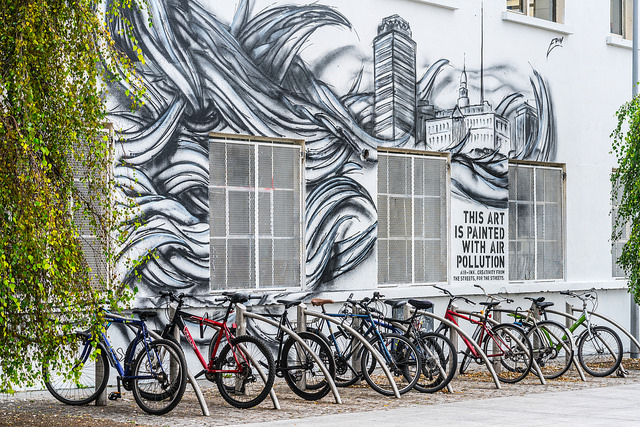
Picture a primordial paradise: you stand at the edge of a cliff as foamy waves crash against the rocky coastline. You feel the cool ocean spray.
But things are about to go terribly wrong.
On cue, lava spews from the ground and the sky darkens with volcanic dust. It gets so hot that the ocean evaporates. And then, with no more ocean to absorb carbon dioxide from the atmosphere, it gets even hotter. You aren’t enjoying this fantasy anymore.
By the way, you just witnessed how Venus—the scorching orb second from the sun—was born. It’s an example of how a planet can go from paradise to inferno. And carbon dioxide is mostly responsible.
Of course, it doesn’t take Venus-levels of carbon dioxide to warm a planet. Earth’s atmosphere only contains a tiny fraction of this gas. Take it away and our world freezes into a sterile snowball. Double it, however, and the temperature rises uncomfortably. Ice caps melt. Sea levels rise. Once fertile areas begin to look like Death Valley. Not Venus, but not exactly Club Med.
Using ice core samples, scientists have been able to look deep into Earth’s atmospheric past. For hundreds of thousands of years, the concentration of carbon dioxide did not exceed 0.03 percent. Then humans began burning coal. And oil. And forests. Now the level sits around 0.04 percent.
This spike in carbon dioxide is, in fact, the prime culprit in Earth’s recent warming trend.
Are humans to blame for this increase in atmospheric carbon? Well, scientists have measured the excess carbon dioxide, and (surprise, surprise) it matches up with human emissions. To seal the case, the surplus carbon bears the mark of industry—a heavier isotope than normal atmospheric carbon.
This souped-up greenhouse—today’s planet Earth—is not a natural phenomenon. We built it.
But now it’s not just smokestacks and refineries warming the planet. We’ve awakened a sleeping giant. As temperatures rise, permafrost—the frozen soil in Northern latitudes—is melting at increasing rates. This melt releases bundles of carbon dioxide and methane into the atmosphere. Methane, unfortunately, is even more potent than carbon when it comes to warming the planet.
Here’s the feedback loop: the planet warms, frost melts, greenhouse gases are released, the atmosphere traps more heat, the planet warms some more, and so on. The amount of gas released from melting permafrost is “on par with current U.S. rates of emission,” said Susan Natali of the Woods Hole Research Center. And try getting arctic frost to show up to a climate convention.
Future feedback loops aside, the consequences of climate change are already serious. In Bangladesh, rising sea levels have forced millions to migrate to Dhaka, the country’s congested capital. Residents cram into huts, eking out an existence amongst hordes of fellow refugees. It’s a real humanitarian crisis.
Another crisis rages in the Western United States, where rising temperatures and extended dry spells have created conditions ripe for forest fires. Acres and acres of trees have burned to ash in these fires, and the problem seems to get bigger and badder with each passing year.
“There is no more wildfire season,” said former California governor Arnold Schwarzenegger. “We now have wildfires all year round.”
Wildfires aren’t the only threat to North American trees tied to global warming. Longer summers have allowed the bark beetle—a pestilence to forests—to reproduce twice in a single season. Over the last 10 years, these critters have killed more trees than all fires combined.
Yet hope remains. The sun and the wind—abundant sources of natural energy—are begging to be properly harnessed. And in many places, we’re starting to harness them in earnest.
But the problem is, it’s still profitable for energy companies to burn fossil fuels and release carbon into the atmosphere. This is simultaneously warming the planet and polluting the air.
I mean, it isn’t legal to dump litter on the ground. It shouldn’t be free or legal to dump waste into the sky either.
Earth may never be Venus, but our industrial habits aren’t helping our planet stay beautiful, green, and full of life. If we want to preserve that life, one thing is clear:
We need to stop burning things sooner rather than later.
~
Sources:
1. IPCC AR5 WG1 (2013), Stocker, T.F.; et al., eds., Climate Change 2013: The Physical Science Basis. Working Group 1 (WG1) Contribution to the Intergovernmental Panel on Climate Change (IPCC) 5th Assessment Report (AR5), Cambridge University Press Climate Change 2013 Working Group 1 website.2. “How the Earth itself could undermine a Paris climate agreement,” Washington Post3. “How do we know that recent CO2 increases are due to human activities?” Realclimate.org4. Image of Dhaka, Bangledesh, Forbes5. “Heat” & “Fire Line,” Years of Living Dangerously
~
Relephant:
Elon Musk’s Wise Words on Climate Change.
~
Author: Brian Stanton
Image: William Murphy/Flickr
Image: William Murphy/Flickr
No comments:
Post a Comment